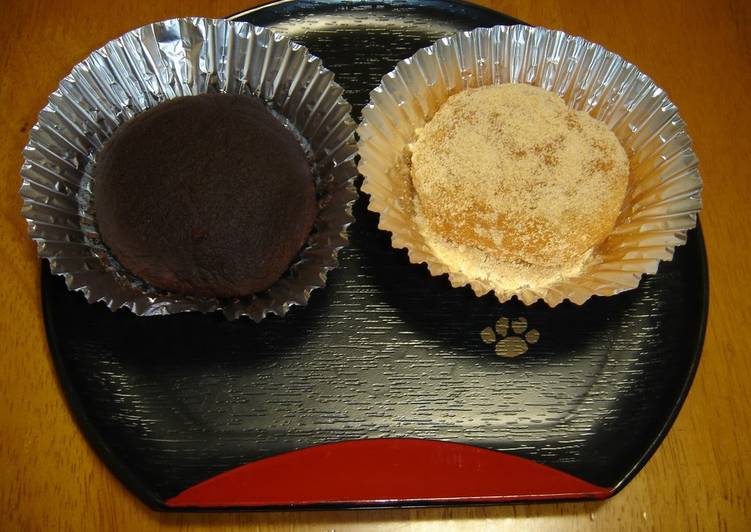Ohagi (to freeze-store for later). Wash the sticky and plain rice together. When you're ready to eat, defrost overnight in the refrigerator. To bring back the ideal texture, Ohagi Ohagi (Botamochi) are not so sweet and they go really well with green tea.
 Commonly enjoyed in Japan during the autumn equinox or during O-bon (a festival for honouring the spirits of one's ancestors), ohagi are made with glutinous mochi rice.
Today we are making "Ohagi," the Japanese traditional red bean mochi.
This sweet is eaten at this time of the year and spring.
You can cook Ohagi (to freeze-store for later) using 12 ingredients and 16 steps. Here is how you achieve that.
Commonly enjoyed in Japan during the autumn equinox or during O-bon (a festival for honouring the spirits of one's ancestors), ohagi are made with glutinous mochi rice.
Today we are making "Ohagi," the Japanese traditional red bean mochi.
This sweet is eaten at this time of the year and spring.
You can cook Ohagi (to freeze-store for later) using 12 ingredients and 16 steps. Here is how you achieve that.
Ingredients of Ohagi (to freeze-store for later)
- Prepare 1 of raw rice : 1 1/2 rice cooker cup Sticky rice.
- You need 1 of raw rice : 1/2 rice cooker cup Plain rice.
- You need 1 tsp of Sugar.
- Prepare 50 ml of Salt water.
- Prepare of Red bean ohagi.
- You need 400 grams of Powdered koshi-an.
- Prepare 120 grams of Sugar.
- Prepare 1 pinch of Salt.
- Prepare of Kinako ohagi.
- Prepare 3 tbsp of Kinako.
- Prepare 3 tbsp of Sugar.
- You need 1 pinch of Salt.
The Ohagi (Formerly known as the White Smiley Tree) is a monster type of the game Monster Box. At spawning, it bursts out from the Monster Box all at once, landing on the ground which then the tree fixes itself to. Ohagi sweet to your cup of tea. In Japanese tea culture, desserts hold an important role.
Ohagi (to freeze-store for later) instructions
- Wash the sticky and plain rice together..
- Let soak in water for 1 hour..
- Once it's done soaking, move the rice to a rice cooker bowl, stir in the sugar, and fill water to the "white rice" line. Adding sugar prevents the sticky rice from becoming too hard..
- While the rice is cooking, prepare the anko. I used this particular powdered koshi-an this time..
- Combine the anko with the amount of water indicated on the package, add sugar, and heat. It will be fairly gooey at first..
- Cook until it's the desired thickness..
- Now prepare the kinako. The kinako-sugar ratio is 1:1, so prepare as much as you like to make. I made 3 tablespoons this time..
- Once the rice is finished, let steam for 10 minutes. Dip a rolling pin or similar rod damped with salt water to slightly mash the rice..
- Moisten a paper towel and wring out excess water. If you don't have paper towels, use cling wrap or a tightly wrung towel..
- Spread bean paste on the paper towel and place the rice on top. Grab enough rice for one ohagi from the rice cooker and cover the rest when not in use..
- You can eyeball the amount of bean paste and rice. It should look something like this..
- Use your fingers to gently stretch the bean paste completely around the rice..
- If the paper towel gets particularly dirty, wash, wring it out, and use it again..
- Since the kinako is just for sprinkling on the outside of the ohagi, they will end up slightly smaller than the ones wrapped in bean paste, so add a bit more rice to make the sizes similar..
- Wrap extra ohagi in cling wrap to prevent drying and freeze..
- These are covered in kinako, but when you defrost the ohagi, the kinako tends to melt, so I recommend defrosting first, then covering with kinako..
With their soft, light flavors they give the perfect base to Ohagi is no different. Recursively freezes the current state, the dispatched action payload if provided and the new state. When mutation occurs, an exception will be thrown. Should be used only in development to ensure that the state remains immutable. Normal Mode Strict Mode List All Children.